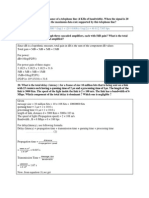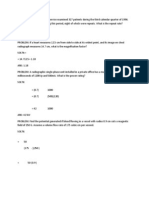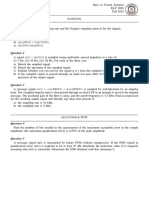A 2 Solution
A 2 Solution
Uploaded by
Jose M. GuerreroCopyright:
Available Formats
A 2 Solution
A 2 Solution
Uploaded by
Jose M. GuerreroCopyright
Available Formats
Share this document
Did you find this document useful?
Is this content inappropriate?
Copyright:
Available Formats
A 2 Solution
A 2 Solution
Uploaded by
Jose M. GuerreroCopyright:
Available Formats
Question 1: If a binary signal is sent over a 3.
1 kHz telephone channel whose signal to noise ratio is 30 dB, what is the maximum achievable data rate? Answer: Using Shannon's formulation for channel capacity: C = W * log2(1 + S/N) Where log2 represent logarithm base 2 30 dB S/N = 1000 S/N C = 3100 * log2(1 + 1000) C = 30,894 bps Hnce the channel capacity is 30,894 bits per second. Question 2: What signal to noise ratio is needed to put a T1 carrier on a 100 kHz line? For the data rate of a T1 signal consult a reference. Answer: Once again using the Shannon's formulation: C = W * log2(1 + S/N) For a T1 system the data rate is 1.544 Mbps. 1544000 = 100000 * log2(1 + S/N) 15.44 = log2(1 + S/N) S/N = (2^15.44) - 1 S/N = 44452.2 S/N = 46.48 dB Hence the signal to noise ratio required is 46.48 dB. Question:3 It is desired to send a sequence of computer screen images over an optical fiber. The screen is 800 X 600 pixels using 256 colours. There are 30 screen images per second. How much bandwidth is needed to transmit this signal?
Answer: The data rate required is: Data rate = 800 X 600 pixels/screen X 30 screens/second X 8 bits/pixel Data rate = 115200000 bits/second = 115.2 Mbps If binary signalling is used then using Nyquist formulation: C = 2*W*log2(M) 115200000 = 2 * W * log2(2) W = 57.6 MHz Hence the bandwidth required is 57.6 MHz. Question:4 How long does it take to transmit an 8 inch by 10 inch image by facsimile over an ISDN B channel? The facsimile digitizes the image into 300 pixels per inch and assigns 2 bits per pixel. Current fax machines go faster than this over ordinary telephone lines. How do you think they do it? Answer: Total data to be transmitted by the facsimile machine: 300 pixels per inch means 300 X 300 = 90,000 pixels per sq. inch 90,000 pixels/ sq. inch X 8 inch X 10 inch = 7,200,000 pixels With 2 bits / pixel total number of bits = 7,200,000 X 2 = 14.4 Mbit The ISDN B channel has a data rate of 64 kbps. So time required to transmit the facsimile page using the ISDN B channel is: Time = 14,400,000 Mbits / 64,000 bits per second Time = 225 seconds Time =3.75 minutes Even though the ISDN B Channel supports higher data rate than the current telephone lines the effect of compression has not been taken into consideration. The fax standards
for use on the current telephone system allow for compression which reduces the amount of data to be transmitted substantially. Question 5: Television channels are 6 MHz wide. how many bits/sec can be sent if 8 level digital signals are used? Assume a noiseless channel. Answer: C = 2*W*log2(M) C = 2 * 6 X 10^6 * log2(8) C = 36 X 10^6 Hz C = 36 MHz Question 6: What is the Thermal noise level of a channel with a bandwidth of 10 kHz carrying 1000 watts of power operating at a temperature of 50 degree Celsius? Answer: N = k*T*W N = 1.381X10^-23 * (50+273) * 10,000 N = 44.61 X 10^-18 Watt Question 7 Given a channel with an intended capacity of 25 Mbps. The bandwidth of the channel is 3 MHz. What signal to noise ratio is required in order to achieve this capacity? Answer: C = W * log2(1 + S/N) 25 X 10^6 = 3 X 10^6 * log2(1 + S/N) 8.33 = log2(1+S/N) S/N = (2^8.33) -1 S/N = 321 S/N dB = 10 * log (321) S/N dB = 25 dB
Question 8: Suppose that a digitized television picture is to be transmitted from a source that uses a matrix of 1600 by 1200 picture elements (pixels), where each pixel represents one of 65,536 colors. Assume that 30 pictures (frames) are sent per second. (a) Find the data rate R of the source in bits per second. (b) Assume that the picture is to be transmitted over a 10 MHz channel with channel capacity equal to the data rate required for the signal. If M-ary signaling is to be used to accommodate the video signal on the channel what smallest value of M is required Answer: For (a) method is same as in Q.3 For (b) use Nyuquist formula and substitute the value of R or C obtained in part (a)
Question 9: Is Nyquist Theorem true for optical fiber, or only for copper wire? Answer: The Nyquist theorem is true regardless of the physical medium. Question 10: (a) Imagine a Signal travels through a transmission medium and its power is reduced to half. Calculate the attenuation (loss of power) in dB? (b) Imagine a Signal travels through an amplifier and its power is increased 10 times. Calculate the amplification (gain of power) in dB? (c) We can calculate the theoretical highest bit rate of a regular telephone line. A telephone line normally has a bandwidth of 3000Hz (300Hz to 3300Hz). The Signal-toNoise ratio is usually 35dB. For this channel calculate the highest bit rate? If we want to send data faster than this, what can we do? Answer: Solution of Part (a) and part (b) in lectures For part (c), first convert the SNR given in dB to S/N using the formula SNR dB = 10 log10 (Signal Power (S) /Noise Power (N) ) and then use Shannons capacity formula to calculate C or R
You might also like
- J9A Manual English 1766 Adndm 2589Document138 pagesJ9A Manual English 1766 Adndm 2589static_fluxNo ratings yet
- Solution Manual For Data Communications and Networking by Behrouz ForouzanDocument5 pagesSolution Manual For Data Communications and Networking by Behrouz ForouzanAel Xander LorescoNo ratings yet
- Tutorial 04Document48 pagesTutorial 04prettyswagNo ratings yet
- InFusion Engineering EnvironmentCourse5612 Participant GuideDocument440 pagesInFusion Engineering EnvironmentCourse5612 Participant GuideJayesh BhadjaNo ratings yet
- Assignment No 2Document10 pagesAssignment No 2muhammadshahzaibf20No ratings yet
- CN # Assinment # 2Document14 pagesCN # Assinment # 2Aj status hive100% (1)
- Section 5 - NetworksDocument28 pagesSection 5 - Networkssherifasker2No ratings yet
- Assignment 1 SolutionasdwaDocument2 pagesAssignment 1 SolutionasdwaFrank Ong100% (1)
- Antar Muka Tugas-Soal 1Document8 pagesAntar Muka Tugas-Soal 1EkaPrasnaNo ratings yet
- M225084 HCS212 Individual Assignment 2Document12 pagesM225084 HCS212 Individual Assignment 2Courtney Kudra DzereNo ratings yet
- M225084 HCS212 Individual Assignment 2Document12 pagesM225084 HCS212 Individual Assignment 2Courtney Kudra DzereNo ratings yet
- ITS323Y09S1E01 Midterm Exam AnswersDocument19 pagesITS323Y09S1E01 Midterm Exam AnswersRachel PacisNo ratings yet
- Chapter 2: Sample Questions, Problems and Solutions Bölüm 2: Örnek Sorular, Problemler Ve ÇözümleriDocument6 pagesChapter 2: Sample Questions, Problems and Solutions Bölüm 2: Örnek Sorular, Problemler Ve ÇözümleriDhana WinksNo ratings yet
- Numericals On Multiple Aces ControlDocument9 pagesNumericals On Multiple Aces ControlSureshNo ratings yet
- DC 1st AssignmentDocument5 pagesDC 1st AssignmentHarshith ShankarNo ratings yet
- Tutorial 4-SolutionDocument11 pagesTutorial 4-SolutionZaidi Mat ZainuddinNo ratings yet
- Data Communication: By:Eng - Alaa I.HaniyDocument8 pagesData Communication: By:Eng - Alaa I.Haniypömo cNo ratings yet
- Datacom Assighment1 SoluDocument7 pagesDatacom Assighment1 SoluRediet ZemedkunNo ratings yet
- CHAPTER 2 - Data & SignalDocument65 pagesCHAPTER 2 - Data & SignalIzzati RahimNo ratings yet
- Unit 1Document3 pagesUnit 1aNo ratings yet
- Tutorial Wireless Basics: Revision of DB, DBW, DBM, DBV, EtcDocument4 pagesTutorial Wireless Basics: Revision of DB, DBW, DBM, DBV, EtcUpul JayasingheNo ratings yet
- Excercise SolutionsDocument4 pagesExcercise Solutionswaseemarain100% (5)
- Assignment 2 SolDocument6 pagesAssignment 2 SolAnonymous jxm0WNS7QaNo ratings yet
- Comp 3271Document6 pagesComp 3271Ambrose S.No ratings yet
- Midterm1 SolDocument7 pagesMidterm1 SolJairo TanyagNo ratings yet
- Datornät Lektion 5 Kapitel 5Document21 pagesDatornät Lektion 5 Kapitel 5von kervy onradeNo ratings yet
- Ex. 5.15.18: A Delta Modulator System Operates at 3 Times Nyquist Rate For Signal With 3.3 KHZ .Document3 pagesEx. 5.15.18: A Delta Modulator System Operates at 3 Times Nyquist Rate For Signal With 3.3 KHZ .S Ahson ASNo ratings yet
- Mob - Mob (TD) - 132Document5 pagesMob - Mob (TD) - 132Bathini RamakrishnaNo ratings yet
- Ot Comm X PDFDocument67 pagesOt Comm X PDFKevin Luis Markus PinedaNo ratings yet
- Homework 2 SolutionDocument5 pagesHomework 2 SolutiongretabunciNo ratings yet
- Analog Communication ExamDocument4 pagesAnalog Communication ExamAdham Albanna100% (1)
- Homework Assignment 1: Physical Layer 18759: Wireless Networks (Max. 100 Points) Due Date:8th Feb (In Class)Document4 pagesHomework Assignment 1: Physical Layer 18759: Wireless Networks (Max. 100 Points) Due Date:8th Feb (In Class)fawal100% (1)
- Tutorial3 ModelanswerDocument6 pagesTutorial3 Modelansweralaraji17.10.1981No ratings yet
- Assignment # 2Document10 pagesAssignment # 2Zeeshan AjmalNo ratings yet
- Data Communication: Numerical On Unit 4: SolutionDocument3 pagesData Communication: Numerical On Unit 4: SolutionaNo ratings yet
- Extra Tut 5 SolsDocument4 pagesExtra Tut 5 SolsNOMPUMELELO MTHETHWANo ratings yet
- Iecep Problem SolvingsDocument85 pagesIecep Problem SolvingsJohn Paul M. Tubig0% (2)
- Assignment 1.solDocument3 pagesAssignment 1.solvanvu123100% (1)
- Problem SolvingDocument13 pagesProblem Solvingenes erçinNo ratings yet
- Tutorial 8Document14 pagesTutorial 8Anon PoetNo ratings yet
- CN Tut1 Data CommDocument25 pagesCN Tut1 Data CommGOHIL AJAYKUMAR SHANKARBHAINo ratings yet
- Chhhpppttteeerrr 55555Document12 pagesChhhpppttteeerrr 55555S Ahson ASNo ratings yet
- Tutorial 2Document3 pagesTutorial 2Anshul Gupta100% (1)
- Fig. P. 5.15.20: DM Signal Part II: Maximum Frequency: GivenDocument3 pagesFig. P. 5.15.20: DM Signal Part II: Maximum Frequency: GivenS Ahson ASNo ratings yet
- Assignment Unit I 3Document21 pagesAssignment Unit I 3Diksha KashyapNo ratings yet
- Solution For Assignment 3Document3 pagesSolution For Assignment 3Faizan 'Fezar' RabbaniNo ratings yet
- Dcby Devils DukeDocument23 pagesDcby Devils DukeTummala JanakiramNo ratings yet
- Basic Questions and Answers Digital NetworksDocument2 pagesBasic Questions and Answers Digital NetworksGuillermo Fabian Diaz Lankenau100% (1)
- PhysicalLayer 3Document40 pagesPhysicalLayer 3Pianto ArtNo ratings yet
- T3-Physical LayerDocument95 pagesT3-Physical Layerutkarsh.shrivastav202002No ratings yet
- Capitulo3 ForusandDocument11 pagesCapitulo3 ForusandOscar RodriguezNo ratings yet
- DC Unit 1 AssignmentDocument2 pagesDC Unit 1 AssignmentMeghashyam SarmaNo ratings yet
- Mobile ComputingDocument7 pagesMobile ComputingDivya NadarNo ratings yet
- AnswerDocument11 pagesAnswerNirvan LI100% (3)
- Sheet SamplingDocument3 pagesSheet SamplingAhmed MohamedNo ratings yet
- Data Communication and NetworksDocument5 pagesData Communication and NetworksNusrat Ullah100% (3)
- Software Radio: Sampling Rate Selection, Design and SynchronizationFrom EverandSoftware Radio: Sampling Rate Selection, Design and SynchronizationNo ratings yet
- 2008 1 PDFDocument7 pages2008 1 PDFJose M. GuerreroNo ratings yet
- Quantitative Comparison of Transient Elastography (TE), Shear Wave Elastography (SWE) and Liver Biopsy Results of Patients With Chronic Liver DiseaseDocument4 pagesQuantitative Comparison of Transient Elastography (TE), Shear Wave Elastography (SWE) and Liver Biopsy Results of Patients With Chronic Liver DiseaseJose M. GuerreroNo ratings yet
- 2015 PDFDocument4 pages2015 PDFJose M. GuerreroNo ratings yet
- 2015 PDFDocument4 pages2015 PDFJose M. GuerreroNo ratings yet
- 2008 PDFDocument7 pages2008 PDFJose M. GuerreroNo ratings yet
- 2008 1 PDFDocument7 pages2008 1 PDFJose M. GuerreroNo ratings yet
- eCTD As An Information MapDocument23 pageseCTD As An Information MapJose M. GuerreroNo ratings yet
- Company To BrokersDocument34 pagesCompany To BrokersJose M. GuerreroNo ratings yet
- Mindmanager Enterprise: Promotes Collaborative Working Practices at ManeDocument2 pagesMindmanager Enterprise: Promotes Collaborative Working Practices at ManeJose M. GuerreroNo ratings yet
- Travel Information CenterDocument21 pagesTravel Information CenterJose M. GuerreroNo ratings yet
- Low Power Implementation of Secure Hashing Algorithm (SHA-2) Using VHDL On FPGA of SHA-256Document6 pagesLow Power Implementation of Secure Hashing Algorithm (SHA-2) Using VHDL On FPGA of SHA-256IJRASETPublicationsNo ratings yet
- EpsonDocument216 pagesEpsonsalih1965No ratings yet
- How To Repair Restore Reinstall Grub 2 With A Ubuntu Live CDDocument7 pagesHow To Repair Restore Reinstall Grub 2 With A Ubuntu Live CDalquimico8No ratings yet
- DP Modem 13115 DriversDocument218 pagesDP Modem 13115 DriversAndyS WicaksonoNo ratings yet
- Lots PDFDocument4 pagesLots PDFGustavo BenitezNo ratings yet
- Galaxy EPS 6000 InstallationDocument72 pagesGalaxy EPS 6000 InstallationFernando PrietoNo ratings yet
- Frequently Asked Questions: Versacamm Sp-540V Wide Format Inkjet Printer/CutterDocument3 pagesFrequently Asked Questions: Versacamm Sp-540V Wide Format Inkjet Printer/CutterUn Poco de TodoNo ratings yet
- Group ProposalDocument6 pagesGroup Proposalapi-383388472No ratings yet
- Operating System Exercises - Chapter 13-SolDocument4 pagesOperating System Exercises - Chapter 13-Solevilanubhav100% (1)
- VXR-7000 Om Eng Eu E13671108Document0 pagesVXR-7000 Om Eng Eu E13671108Edinaldo GuimaraesNo ratings yet
- Design and Optimization of A Formula SAE VehicleDocument163 pagesDesign and Optimization of A Formula SAE VehiclesadsdNo ratings yet
- Matlab Report GeneratorDocument8 pagesMatlab Report GeneratorMohamed SaeedNo ratings yet
- Ligar Aquecedores PRO 8100Document7 pagesLigar Aquecedores PRO 8100wodson lemosNo ratings yet
- English PW9140Document122 pagesEnglish PW9140Gigi DurulNo ratings yet
- Acoplamento OKDocument28 pagesAcoplamento OKMarcelo KendrickNo ratings yet
- H600 y L800 PDFDocument36 pagesH600 y L800 PDFJose MarcanoNo ratings yet
- Immobilizer (Textbook, Slide) - HMCDocument108 pagesImmobilizer (Textbook, Slide) - HMCSai Pramod100% (3)
- Can Rig LWCV Actuator ManualDocument58 pagesCan Rig LWCV Actuator ManualAhmed Magd100% (2)
- Trilogy MiuDocument2 pagesTrilogy MiuaksiiskaNo ratings yet
- Resume Chicago Account Executive Tamika BrownDocument2 pagesResume Chicago Account Executive Tamika BrownOtis CollierNo ratings yet
- WEG Guia de Instalacao pws5610 Quick Guide English PDFDocument1 pageWEG Guia de Instalacao pws5610 Quick Guide English PDFÁgó AttilaNo ratings yet
- SUSHWANTH Dynamic Cache Management TechniqueDocument33 pagesSUSHWANTH Dynamic Cache Management TechniqueSunil ReddyNo ratings yet
- CM168 MunichDocument59 pagesCM168 MunichekartorNo ratings yet
- TTC-450 Firmware Update Content OverviewDocument7 pagesTTC-450 Firmware Update Content Overviewjose.mauvetNo ratings yet
- Percona Server Installation: Running PMM Server Via DockerDocument3 pagesPercona Server Installation: Running PMM Server Via Dockerhari krishnaNo ratings yet
- Tabela Centro PioneerDocument26 pagesTabela Centro PioneerCesar MckayNo ratings yet
- C++ NotesDocument30 pagesC++ NotesKhayam KhanNo ratings yet
- Legris Installation of FittingsDocument30 pagesLegris Installation of Fittingsritesh_4luv7679No ratings yet



































































































